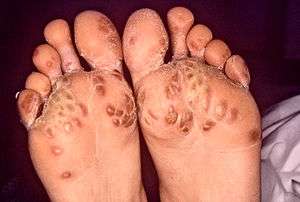Keratoderma blennorrhagicum
| Keratoderma blennorrhagicum | |
|---|---|
 | |
| 'The rash on the bottom of this individual’s feet, known as keratoderma blennorrhagicum, was due to Reiter's syndrome, not a syphilitic infection as was initially suspected' - CDC/ Dr. M. F. Rein | |
| Classification and external resources | |
| ICD-9-CM | 701.1 |
| DiseasesDB | 21855 |
| MeSH | D007642 |
Keratoderma blennorrhagicum etymologically meaning keratinized (kerato-) skin (derma-) mucousy (blenno-) discharge (-rrhagia) (also called keratoderma blennorrhagica)[1] are skin lesions commonly found on the palms and soles but which may spread to the scrotum, scalp and trunk. The lesions may resemble psoriasis.[2]:195
Keratoderma blennorrhagicum is commonly seen as an additional feature of reactive arthritis in almost 15% of male patients. The appearance is usually of a vesico-pustular waxy lesion with a yellow brown colour. These lesions may join together to form larger crusty plaques with desquamating edges.
See also
References
External links
This article is issued from Wikipedia - version of the 5/18/2016. The text is available under the Creative Commons Attribution/Share Alike but additional terms may apply for the media files.
